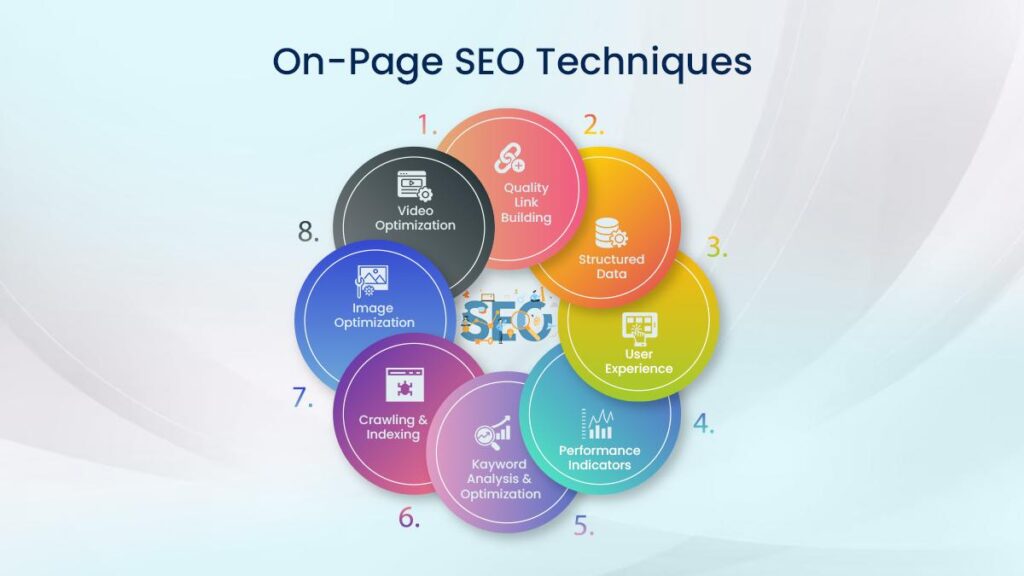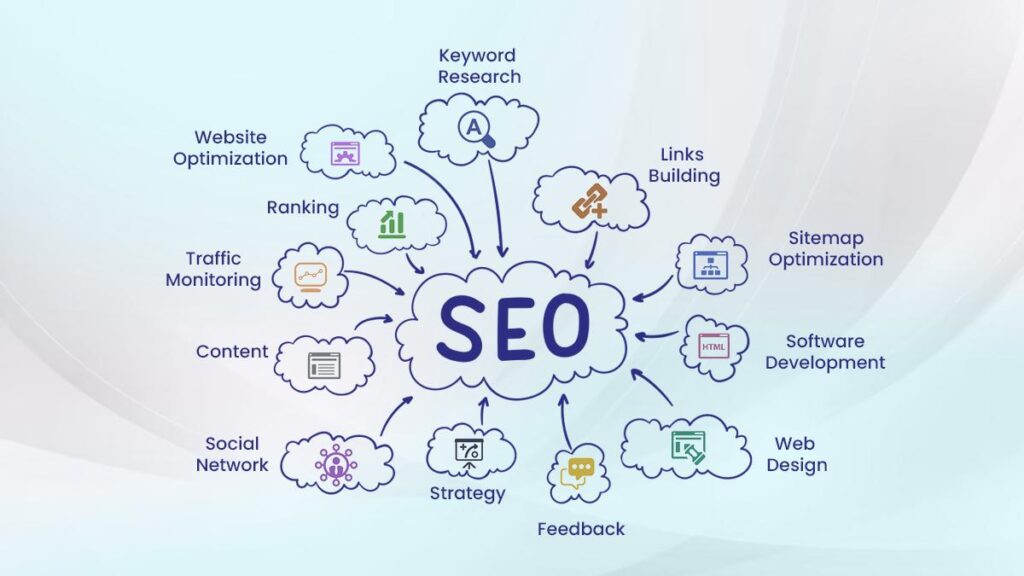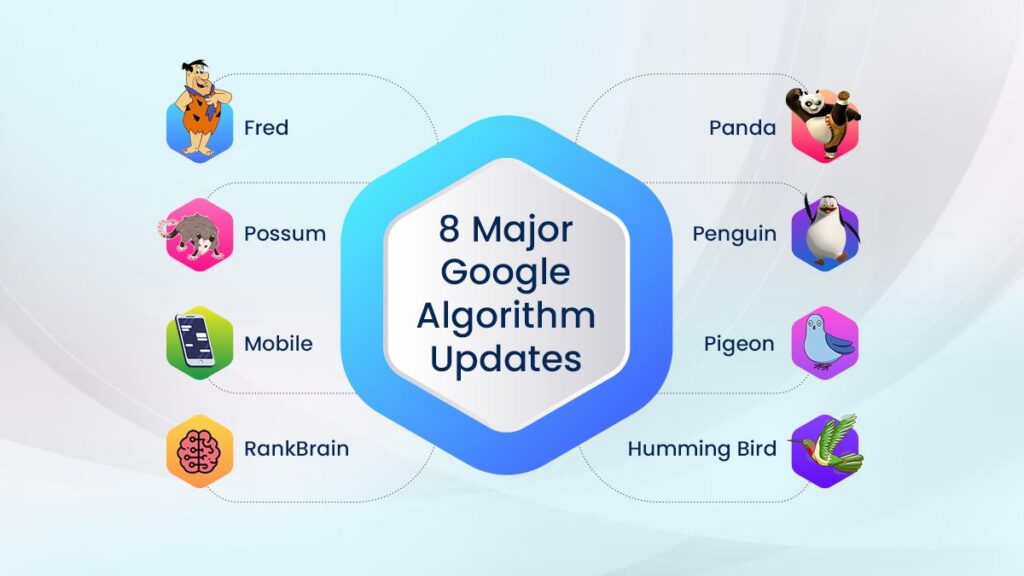Search Engine Optimization has become a core processor for a healthy business system. The primary and most crucial goal of B2B SEO is to drive organic traffic to the website and acquire the highest SERP rankings on search engines.
B2B SEO has been a concern for organizations in their sales growth. This obligates stakeholders and decision-makers to handpick different strategic approaches to attain their desired business goals.
Let’s break down these B2B SEO techniques and identify the factors driving organic traffic on the website:
What is B2B SEO?
Business-to-business (B2B) SEO is a tactic implemented to stimulate organic traffic using high-quality keywords. An enticing B2B SEO strategy ranks your business’ website to the targeted audience searching for particular services and products you deliver.
- 75% of internet users rarely browse beyond the first page of search results.
- In 2023, according to 57% of B2B marketers, SEO produces more leads than any of their other marketing endeavours.
The cardinal factor that makes B2B SEO so renowned is its business deliverables. Organizations that are building their brand from scratch can ultimately utilize the SEO strategy to attain business success and growth in the following areas:
- Long-lasting user impression.
- Superior credibility & business stature.
- Growth in sales and business pipelines.
- Streamlined user experience (UX).
- Cost-effectiveness.
- Industry leaders’ appearance against business competitors.
Let us enumerate the strategies that are involved in delivering high-quality B2B SEO performance results.
Result-Oriented B2B SEO Strategy for Business Growth
The primary bone-bearing effect of having fully SEO-optimized traffic-generating mediums, which include websites and social media accounts, can chart your business to the next level, making your brand appear in the higher ranking in the SERP list.
The peculiarities witnessed in optimizing B2B SEO can be fatiguing, but active attention can alter the overall perspective toward the complexity of B2B SEO.
1. On-Page SEO

On-page SEO streamlines optimizing various elements of the websites displayed in search engines. The content added on the web pages is analyzed for direct quality traffic on your websites, as the term on-page SEO refers to various content presented under HTML code.
The Best On-page SEO Strategies
1. Relevant Keyword Integration in Website
- A business website gets picked on search engines when it contains the essential keywords. The pages must be tweaked with adequate keywords to achieve higher search traffic and avoid overstuffing keywords.
- Start off with keyword research using automated tools such as Semrush, HubSpot, and Google Trends to obtain keywords for your website.
- The pre-eminent emphasis deviates towards acquiring long-tail keywords. Find ways to have them added to the pages, as they have the potential to attract superior-quality traffic to your website.
- Long tail keywords have acquired a higher click-through rate (CTR) of 3-5 % higher than generic searches.
2. Optimization of Your Meta Description & Title Tags
Meta description is the small excerpt under the title tag. It acts as a guide to deliver the overall summary to the readers for opting for your website from the list.
Persuasive descriptions include:
- Maximum 155-160 character limit.
- Utilizing primary keywords without interruption.
- Presenting the outline of the website.
Title tags are the short texts that users hover over to find a page from the website. The search engine’s algorithm determines if the content is pertinent to their query parameters.
Clickable titles include:
- 55-60 character limit.
- Punchy and powerful phrases.
- Primary Keyword placement at the beginning of the text.
3. Create Audience-based Content
The integral unit in B2B SEO is content marketing; it is a medium for the targeted audience to find their way to your website. To achieve higher SERP performance, marketers must focus on creating informative and associative content of the highest calibre.
Factors to remember in content creation:
- Curate easy-to-read headline.
- Intent of the content is delivered faster in points against lengthy texts.
- Inclusion of relevant graphic images is a bonus.
4. Optimization of Added Images
Graphic images that are included in the website can appeal to the targeted audience. Having the images advances the overall ambiance of the website, making it appear more engaging.
Routine practices for image optimization:
- The more extensive the image file, the slower your website becomes. It is crucial to have images compressed before publishing them to avoid adverse effects on SEO.
- Including image alt tags makes search engines read what the image is about with its small descriptive information.
5. URL Optimization
One of the high-priority facets of On-page SEO is optimizing the URL that search engines pick up to assess the applicability of the website. Furthermore, involving the breadcrumb navigation technique can support the formation of a decent yet fully optimized URL.
6. Utilize Internal Links
Internal links are the portals that direct users from one page to another by anchoring relevant texts. Marketers must proactively plan the content based on search engines’ code of practice. This enables search engines to rank and index your web page for higher visibility and encourages users to surf for a while longer.
2. Technical SEO
The primary objective of technical SEO is to focalize the technical aspects involved in the seamless functioning of the website. It ascertains the elements, such as indexing of web pages, rendering, and crawling, are optimized to deliver an impeccable UX experience with compliance to search engine standards.
Vital strategies to implement B2B Technical SEO are:
- Faster loading speed.
- Mobile-friendly website interface.
- A chronological framework of your websites.
- Compelling URL links.
- Internal links and navigation are prominent.
- Fix broken links and error pop-ups.
- Remove duplicate and obsolete content.
- List the authoritative URLs.
3. Off-Page SEO
Off-page SEO can be simplified as an activity performed outside your website for optimization and gaining authority as a brand. Obtaining backlinks is one of the techniques used to develop brand credibility in the market.
55.24% of the websites have failed to obtain backlinks on their web pages.
Let’s guide you through the other off-page SEO strategies that can be involved in B2B SEO optimization:
- Guest blog post writing
- YouTube content creation
- Establish email outreach
- Social media marketing
- Design a referral program
- Accumulate experts’ feedback and reviews
- Creating content for Web 2.0 websites
- Attending public forum meets
- Involve influencers in outreach marketing
- Repair of existing broken links
4. Local SEO

Local SEO is the act of tailoring your digital footprint at a respective local location. Operating businesses employ this technique to get listed for specific local search keywords.
The importance of fully optimized local SEO can make a real difference in sales conversion and amplify in-store foot traffic. Implementing local SEO provides persuasive online visibility for your brand, a positive brand image to users, prospective clientele queries, and more.
Google Maps is used by 86% of the populace to locate businesses.
Here’s a list of techniques that can be incorporated for the optimization of local SEO:
- Enroll in Google My Business (GMB).
- Proactively engage in building local links.
- Make use of schema markup code.
- Get displayed and featured on potential review sites.
- Upgradation of business objectives, website link (URL).
- Draw in various Google posts to your GMB account.
Importance of Analytics in B2B SEO and Its Strategies
SEO analytics is the process of monitoring generated metrics and interpreting authentic data to identify the traffic generation on your website. SEO Analytics enables marketers to spot the fixable data areas of the website to maximize the ROI while optimizing your B2B SEO.
What is Google Analytics?
Google Analytics is an SEO tool that simplifies complex data and provides fundamental analytical abilities for marketers to identify and rectify the areas for improvement.
Practical usage of Google Analytics (GA) can assist you in refurbishing the technical difficulties faced while researching keywords, link building, marketing the content, page optimization, and more.
Every marketer must use the best SEO analytics tool and data-driven approach to optimize website segments. Developing a concise, data-driven plan delivers clarity regarding your overall brand visibility and areas for improvising methods implemented earlier. Here are a few factors to consider while implementing a data-driven SEO strategy for your B2B business growth:
- Monitor the user interaction for optimization of pages.
- Ensure superior SEO rankings in the search list.
- Building of back-links using data-driven insights.
- User-friendly impression analysis.
Ideal Implementation of Google Analytics for SEO Performance Monitoring
Google Analytics is utilized for monitoring website performance and accumulating the data of visited users. Business organizations are extracting the most to segregate the sources for traffic generation, advertise campaign performance metrics, regulate and set new business goals based on accomplishments, pick up the patterns depicted by users, and more.
Let us glance at the practice routines of using Google Analytics (GA) to monitor your SEO performances:
- Inclusion of annotations for tracking content updates.
- Finding referral platforms and websites.
- Magnify the SEO growth of the pages that are converting.
- Implement a Multi-Channel Funnel report.
- Targeting internal site search to extract new keywords.
- Tracking of the content by adding relevant notes.
Best Tools For Optimization of B2B SEO
SEO tools safeguard your precious time against challenging data and tiresome keyword research analysis. These tools provide an upper business edge against market competitors, making it a must to opt for automated tools prone to delivering optimal results. Automated SEO tools oversee monotonous tasks and make marketers productive to strategically operate on other noteworthy aspects. It has the potential to outrun multiple facets of SEO optimization with few clicks.
Here’s a list of SEO optimizing tools that can multifold your brand’s web presence:
1. Google Analytics
Ideally used for evaluation of market trends, website traffic analysis, tracking of keyword ranking, and technical SEO Audit.
2. Ahrefs
Designed to meet the needs of competitors with keyword evaluation, backlink analysis, and ideas for research-based content.
3. Semrush
Optimal choice for keyword research, technical SEO, content ideas generation, and off-page SEO.
4. MOZ
Provisioned for researching keywords, local SEO, optimization of research links, and SERP features’ optimization.
5. BuzzSumo
Geared primarily towards inventive content research and off-page SEO.
Voice & Mobile SEO Optimization and Its Strategy
Voice search optimization is the act of getting your brand enlisted higher in the voice search list for adequate visibility. The objective is to be chosen by various voice assistants for reading out loud when performing a voice search by targeted users.
Here are a few tactical strategies that you might use to optimize your website for voice searches:
- Usage of high-quality, precise keywords for voice search.
- Analyze the existing keyword search results from the SERP list.
- Clear-cut optimization of web content for user-friendly voice searches.
- Polished technical SEO pages.
- Local SEO optimization.
- Constant performance monitoring and analysis.
Mobile SEO optimization is the straightforward process of optimizing your website and making it compatible with mobile devices, tablets, and more. A well-customized mobile website has a colossal impact on the business conversation and overall brand effectiveness.
Mobile-first indexing thrives on the uploaded content, which is presented for ranking and indexing of the webpage. Websites that need to be more optimized or have fewer content elements will be dragged down by the search engine to reposition them differently in the SERP performance.
- 27.7% of clicks are directed to the top organic mobile ranking from the list.
- 52% of B2B search inquiries are carried out on smartphones; the count is set to reach 70% by the end of 2023.
- Google drives 96% of smartphone internet traffic.
- Conversion rates take a dip down to 12% for each second taken by the website to load.
Here’s a list of the strategies that web developers and marketers predominantly resort to mobile SEO optimization:
- Optimize the loading speed of your website.
- Design your website to be more interactive and friendly to use.
- Effectively include content materials on the website.
- Ensure to incorporate structured data for mobile SEO.
- Implement keywords that are voice search user-friendly.
- Meta tag optimization and constant surveillance of keyword placements.
Remain Authoritative on the Latest Google Algorithm Updates

Google algorithms are intricate techniques designed to quickly descend the superior relevant results by running a check in its search index database. Various ranking variables and algorithms are deployed to deliver numerous flawlessly optimized websites based on their relevance in the SERP search list.
The prevailing fact about Google’s algorithm is that it evolves on constant updates, which is a disadvantage to businesses and marketers. It will be challenging for marketers to keep an eye on the latest updates. When missed, it can trigger poor brand visibility and low appearance in the SERP ranking.
Invest a few hours to get acquainted with the latest updates that can be utilized within a few years. This would solidify your understanding of the areas of search engine requirements and its potential features. These latest updates would guide your SEO optimization strategies and help you comprehend the necessary changes to incorporate into your website.
Tools that can apprehend the latest algorithm updates using website performance metrics are Google Analytics, Google Search Console, and more.
Final Words
The urgency for developing invincible B2B SEO-optimized techniques is the dream for most established businesses. Understanding the basics required to get enlisted on the SERP pages can be achieved by systematically utilizing elements such as meta tags, images, well-researched keywords, and impeccably engaging content for content marketing, which can get you the lead against your competitors.
Other significant techniques, such as on-page, off-page, and local SEO, can set the tone for your brand right from the top. When analyzed effectively, these techniques must be monitored, and the gained metrics can help you in the area of errors that can be plastered using advanced SEO tools such as Google Analytics, Ahrefs, Buzzsumo, and more.
Are you looking to optimize your SEO strategy but don’t know where to begin? Our fully certified SEO team is ready to help boost your search rankings and drive more visitors to your website. To get started, call (416)-410-7090 or contact us here.
